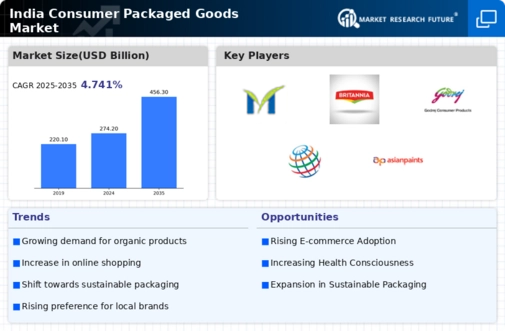Rising Disposable Incomes
India's economic growth has led to a notable increase in disposable incomes, which is a crucial driver for the consumer packaged-goods market. As households experience higher income levels, they tend to spend more on quality products, including premium food items, personal care, and household goods. Recent statistics suggest that the middle-class population is expected to reach 600 million by 2030, further fueling demand in the consumer packaged-goods market. This demographic shift indicates that consumers are willing to pay more for brands that offer quality and value, thus creating opportunities for companies to introduce innovative products that cater to this evolving consumer base.
Diverse Consumer Preferences
India's diverse cultural landscape leads to varied consumer preferences, which is a significant driver for the consumer packaged-goods market. Different regions exhibit distinct tastes and preferences, necessitating tailored product offerings. For instance, while northern consumers may prefer dairy products, southern consumers might favor rice and lentils. This diversity presents both challenges and opportunities for brands aiming to penetrate the market. Companies that can adapt their product lines to meet regional demands are likely to succeed in the consumer packaged-goods market. Furthermore, understanding local preferences can enhance brand loyalty and consumer trust.
Urbanization and Changing Lifestyles
The rapid urbanization in India is reshaping consumer behavior, significantly impacting the consumer packaged-goods market. As more individuals migrate to urban areas, their lifestyles evolve, leading to increased demand for convenience-oriented products. Urban consumers often seek ready-to-eat meals, packaged snacks, and personal care items that fit their fast-paced lives. According to recent data, urban areas account for approximately 35% of India's population, yet they contribute over 60% of the total consumption in the consumer packaged-goods market. This shift indicates a growing market potential, as urban consumers are more likely to spend on premium and innovative products, thereby driving growth in this sector.
Increased Focus on Quality and Safety
As consumers become more health-conscious, there is a growing emphasis on quality and safety in the consumer packaged-goods market. Indian consumers are increasingly scrutinizing product labels, seeking transparency regarding ingredients and sourcing. This trend is particularly evident in food and beverage categories, where safety standards are paramount. Recent surveys indicate that over 70% of consumers prioritize quality over price when making purchasing decisions. Brands that prioritize quality assurance and adhere to safety regulations are likely to gain consumer trust and loyalty, thereby enhancing their market position in the consumer packaged-goods market.
Digital Transformation and Technology Adoption
The ongoing digital transformation in India is significantly influencing the consumer packaged-goods market. With the proliferation of smartphones and internet access, consumers are increasingly turning to online platforms for shopping. E-commerce sales in the consumer packaged-goods market have surged, with estimates indicating a growth rate of over 25% annually. This shift not only enhances convenience for consumers but also allows brands to engage directly with their customers through digital marketing strategies. Companies that leverage technology to optimize their supply chains and enhance customer experiences are likely to gain a competitive edge in the consumer packaged-goods market.
















Leave a Comment